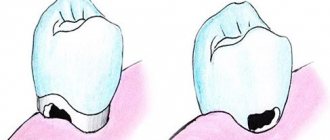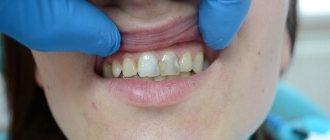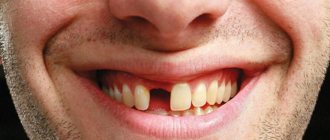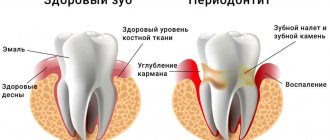Caries of the front teeth can lead to chipped enamel, severe pain and even a change in diction. In addition, it creates an aesthetic problem, as it makes the smile unattractive. If left untreated, it spreads to adjacent incisors. We will tell you why caries occurs on the front surface of the tooth, how it manifests itself and how to get rid of it.
The front teeth of a person are called 8 incisors and 4 canines, which fall into the smile zone. Any enamel damage in this area looks unaesthetic. In this case, most often the front teeth are affected by caries - a slow-moving pathological destruction of the hard tissues of the tooth (dentine).
In this article
- Causes of caries on the front teeth
- What caries looks like in the front teeth: symptoms
- Types of caries in front teeth
- Types of caries of incisors according to the form of occurrence
- Types by localization of the pathological process
- Black classification
- Diagnostics
- How to treat caries on the front teeth
- How to treat caries at an early stage
- Treatment for medium and deep stages of caries
- Treatment for severe crown lesions
- Treatment of caries of anterior teeth in children
- Complications
- Prevention of caries
The most common cause of this disease is the proliferation of cariogenic microbes. However, there are other factors leading to its development. Let us tell you why caries of the front teeth begins.
Causes of caries on the front teeth
Doctors distinguish two groups of caries factors - local and general. The first include:
- Poor oral hygiene. Lack of dental care or improper brushing leads to the formation of deposits on the enamel and gums. Over time, they accumulate and bacteria begin to multiply in them, which destroy hard tissue.
- Disruption of the salivary glands. Saliva washes germs off your teeth and neutralizes toxins created by germs in your mouth. If it is produced in insufficient quantities, the number of microorganisms increases, and the amount of their metabolic products also increases. As a result, they cause decay and damage to dentin.
- Anatomical features of the jaw and tooth structure. Their crowding leads to the rapid accumulation of plaque, as more places appear in the oral cavity that are difficult for toothbrushes to reach. An incorrect bite can also lead to tooth decay. In some cases, it becomes a consequence of carious lesions.
- Poor nutrition. The bacteria that cause tooth decay feed on carbohydrates. The more a person eats sweets, the higher the likelihood of pathology.
There are also common factors for the development of caries on the front teeth. Among them:
- Biological: heart and vascular diseases, endocrine pathologies, gastrointestinal problems, medications, weak immunity, genetic predisposition, stress.
- Environmental factors: poor ecology, unfavorable climate, drinking soft water devoid of minerals, lack of sunlight.
- Social: work in hazardous conditions, childhood, etc.
In children, caries occurs more often than in adults, in women - more often than in men, in white people - more often than in representatives of the Negroid race. This disease affects the front teeth more often than molars and premolars. This is due to the fact that the enamel on them is thinner than on chewing teeth, so they are more vulnerable to external factors and microbes. Let us tell you how caries manifests itself on the front teeth.
Prevention
To increase resistance to caries (caries resistance) it is recommended:
- Maintain oral hygiene (proper cleaning of the mouth, rinsing after meals);
- change your diet (reduce sweets, add solid vegetables and fruits);
- treat otitis media and diseases affecting the nasopharynx in a timely manner;
- take fluoride supplements.
Professional teeth cleaning is one of the preventive measures
Fluorine increases the resistance of enamel, forming fluorapatite. In addition, fluorides:
- normalize metabolism in dental tissue;
- inhibit the growth of microorganisms;
- reduce the rate of formation of acids that destroy teeth.
Therefore, if there is a low level of fluoride in the water in the region, it is recommended to drink fluoridated water, and also more often add sea fish and canned food made from it, seaweed, parsley, and tea to your food. And also use toothpaste with fluoride.
Sodium fluoride intake is 250 days a year with a break in the summer months. Subject to compliance with the timing and method of application, a reduction (decrease) of caries of primary teeth by 70-93%, and of permanent teeth by 30-60% is ensured.
What caries looks like in the front teeth: symptoms
Symptoms depend on the degree and type of disease. The main symptoms of incisor caries:
- sensitivity of the front teeth: accompanied by pain when the enamel is exposed to sour, sweet, hot or cold foods;
- the appearance of dark or white spots on the enamel, which indicate areas of demineralization;
- visible destruction of crowns, chips, cracks, formation of cavities that gradually increase;
- inflammation of the internal tissues of the pulp (pulpitis) or the ligaments holding the tooth in the alveolus (periodontitis);
- putrid odor from the mouth, which can only be hidden with the help of mint toothpaste or chewing gum.
At the initial stage, the disease may not manifest itself, but if any of the listed signs occur, you should consult a dentist. There are also specific symptoms characteristic of one form or another of caries. Let's look at the types of this disease.
How is caries between teeth treated?
Since it is easier to treat interdental caries in the initial stages, timely consultation with a doctor is important. Independent attempts to get rid of the problem will not give the desired result and can only aggravate the situation. SO DO NOT SELF-medicate under any circumstances!
There are no differences in the treatment methods for classical caries and interdental caries. The same methods are used to combat the infectious process. The carious process in the initial stages can be stopped using gentle techniques that do not involve drilling. This is especially important when the front teeth are affected, where it is much more difficult and at the same time more important to achieve good aesthetics.
The difficulty in treating interdental caries lies in the inaccessibility of the affected tissues. Therefore, an experienced dentist should deal with the problem. Since removing cavities between teeth is more difficult and involves working on two teeth, treatment may take longer and be more expensive.
Standard stages in the fight against interdental caries:
- 1. Local anesthesia. It is carried out using proven safe drugs.
- 2. Doctors at our clinic use a rubber dam to isolate the work area while working. But this is not a mandatory step and is not done in every dental clinic.
- 3. Removal of infected tissue. It is carried out with a drill. In some cases, using a microscope to achieve pinpoint accuracy (our clinic has such a microscope).
- 4. Cleaning and treatment of root canals. Chlorhexidine is used for disinfection. An adhesive mixture is also applied to better fix the filling.
- 5. Installation of a seal. Durable materials are used to achieve ideal aesthetics, which is especially important for the smile area. Once the filling is placed, the grinding process begins to achieve the ideal tooth shape.
- 6. If the damage is too severe, we use restoration methods. We often use ceramic veneers.
To receive timely dental care and eliminate caries between the upper or lower teeth, you need to have preventive examinations at the dentist every six months.
Types of caries in front teeth
Caries on the incisors is classified on several grounds. So, according to the degree of development it is:
- Beginners. An unnatural white spot can be seen on the surface of the enamel, which is a consequence of the leaching of minerals from this area of the tooth. At this stage, caries is treated with the help of remineralization - restoring the balance of minerals in the enamel structure.
- Superficial. If the initial stage of the disease is left unattended, the white spot begins to darken and becomes rough to the touch. There is increased sensitivity to sweet and sour foods, and to cold.
- Average Dark yellow or brown cavities form on the tooth. Their sizes and shapes may vary. Lack of treatment leads to the growth of pathological areas.
- Deep. The last stage of caries, which is accompanied by the destruction of hard tissues. The tooth may break into several pieces. The dark spot spreads over the entire surface of the enamel, penetrating into the dentin, so the painful sensations intensify. A tooth can hurt just like that, without being affected by food or drinks.
It is advisable to get rid of caries on the front teeth at the initial or superficial stage, because it progresses quickly in this area of the jaw.
Stages of caries: symptoms, diagnosis
It is customary to distinguish 4 successive stages of caries development. Each stage is characterized by its own symptoms, as well as visual and instrumental examination data, which is important to consider when diagnosing caries.
- Caries in the white spot stage (Fig. 1) - manifests itself in the form of white spots on the surface of the enamel, which are nothing more than foci of demineralization. Their formation is associated with cariogenic microorganisms that metabolize food debris in the oral cavity, converting them into organic acids. The latter, upon contact with tooth enamel, begin to dissolve its mineral matrix, which leads to the loss of calcium (hydroxyapatite) by the enamel.
It should be especially noted that at this stage of caries the appearance of the actual carious defect is not yet observed. The changes concern only the appearance of white spots of a chalky or gray hue, the surface of which lacks shine (characteristic of healthy teeth), and roughness of the enamel in the spot area is also observed. If you scratch the enamel with a sharp instrument, it is easily scraped off, leaving a defect. Apart from aesthetic ones, patients at this stage usually do not present any other complaints.
In order to clearly show patients the degree and number of areas of enamel demineralization, after removing plaque, teeth are treated with aniline dyes (1% solution of methylene blue or caries detector). Dyes temporarily stain areas of demineralization dark, clearly showing the extent and extent of the problem. At the same time, healthy dense enamel is not susceptible to such staining with dyes.
→ Treatment of the initial form of caries
- Superficial form of caries (Fig. 2) - a defect is formed within the layer of tooth enamel, without damaging the dentin underlying the enamel. Typically, superficial caries occurs in areas of demineralization of tooth enamel, i.e. is the next stage in the development of caries in the white spot stage. The formation of a carious defect at the site of a white spot occurs if oral hygiene does not improve, which means that the influence of organic acids and calcium loss continue.
At some point, calcium becomes so low that the enamel framework itself begins to collapse and, accordingly, a superficial carious defect appears. This is especially clearly visible in Fig. 2, where superficial carious defects have formed against the background of foci of demineralization (in the form of white spots). Once again, we draw your attention to the fact that the bottom of the carious defect in superficial caries never extends beyond the enamel-dentin border.
Patients complain of pain from sour, salty, sweet foods, which, however, quickly disappear immediately after the influence of the irritant is eliminated. In addition, if the carious defect is located on the visible surface of the front teeth, patients note a cosmetic defect. An instrumental examination of the carious cavity shows that its edges are soft, the enamel easily chips under mechanical pressure with a sharp instrument (24stoma.ru).
→ Treatment of superficial forms of caries
- Average caries (Fig. 3) - in the absence of timely treatment, the carious defect increases, spreading beyond the enamel-dentin border. Thus, the bottom of the carious cavity will be located in the upper or middle layers of dentin (without affecting its deep layers directly surrounding the dental pulp). When examining a carious cavity, it is clear that it is filled with food debris and decay of hard tooth tissue. There are usually no complaints from patients other than aesthetic ones.
→ Treatment of average caries
- Deep form of caries (Fig. 6) - in the absence of timely treatment, the carious process spreads to the deep layers of dentin, so that between the dental pulp (neurovascular bundle) and the bottom of the carious cavity, only a very thin layer of healthy dentin remains. With this form of caries, patients usually complain of pain arising from temperature stimuli (especially cold) and sweets. Moreover, the pain quickly passes when the stimulus stops.
However, if the carious cavity is simply clogged with food debris and decay of hard tooth tissues, the pain syndrome may be weak or absent altogether. In addition, patients may complain of pain when chewing, which is associated with the pressure of hard food on the bottom of the carious cavity while eating. Visually, the carious cavity is usually large in size, but may also have a small entrance hole. There is pain when probing the bottom of the carious cavity and in the area of the enamel-dentin border.→ Treatment of deep caries
Types of caries of incisors according to the form of occurrence
According to the form of occurrence, the following types of caries are distinguished:
- Acute: develops rapidly, in 10-14 days the disease passes through the initial, superficial and middle stages.
- Chronic: occurs slowly, gradually destroying the enamel and turning it dark. Caries takes on this form when the main factors that provoked the disease no longer affect the body, but no treatment was provided.
- Multiple: caries occurs in several places on the same tooth or on different teeth.
- Secondary: formed under an installed filling.
In this case, secondary or multiple can occur in both acute and chronic forms. For some people, caries practically does not go away, but does not bother them with pain or other symptoms. However, their teeth slowly deteriorate, increasing the risk of their removal.
Types by localization of the pathological process
Caries of the anterior teeth is localized:
- Cervical: caries begins near the neck in the gum area or under it. The main reason for this is poor oral hygiene.
- Interdental: carious lesion is observed between two incisors. Often this type of disease occurs with a small gap between them. This is where food debris gets stuck, which decomposes and causes damage to the enamel.
- Fissure: affects the grooves on the tips of the teeth. Typically, this form of the disease develops on molars, rather than on incisors and canines.
Most often, caries of the front teeth is interdental. If left untreated, the stain spreads to both incisors. If the disease starts, a hole will form between the teeth, which will be difficult to repair. At any moment, enamel and hard tissues can split into several parts.
Causes
The development of carious formations in the dentin of the front teeth is caused by various reasons - general and specific.
Most often, the occurrence of caries in the front teeth is associated with general omissions regarding hygiene and a healthy lifestyle:
- poor quality, untimely cleaning, stuck food residues;
- lack of vitamins and minerals in the human body;
- unbalanced diet with a predominance of carbohydrate foods;
- accumulation of tartar and plaque on enamel;
- untreated gaps, gaps between teeth, and malocclusion.
In addition, there are a number of specific reasons that arise under the influence of objective factors that the patient cannot influence:
- genetic predisposition to the appearance of carious formations;
- the presence of gastrointestinal diseases that affect oral health;
- injuries to the jaw and teeth, which cause microscopic cracks in the enamel;
- chronic diseases of dental tissues, which negatively affect their strength and ability to resist the effects of bacteria;
- insufficient secretion of salivary fluid;
- low saliva acidity;
- immune diseases, due to which a weakened body is unable to resist bacteria and microbes.
- The occurrence of caries can be influenced even by such indirect factors as the climate in the patient’s place of residence, the level of everyday stress, as well as the state of pregnancy and breastfeeding in women.
Black classification
American dentist Green Black developed his own classification of caries, dividing it into classes:
- 1st class: carious lesions are localized in fissures;
- 2nd class: the pathological focus is localized between the molars;
- 3rd class: caries affects the areas between the incisors and canines;
- 4th class: the disease develops along the edges of the front teeth;
- 5th class: the affected area includes the cervical area;
- 6th grade: caries affects the cutting edges of the front teeth.
During the diagnosis, the doctor determines the degree and type of caries of the front teeth, based on which he selects treatment.
Diagnostics
It is not always possible to detect caries at the initial stage, since it can be localized on the back side of the tooth. Therefore, dentists recommend coming for an oral examination every six months. During diagnosis, the doctor uses a detector staining method. It allows you to distinguish caries from other similar diseases: fluorosis, enamel hypoplasia, tetracycline teeth, etc.
The dentist can also probe the cavity to assess the nerve's response to exposure. If deep caries is suspected, the patient is sent for an x-ray of the jaw. After the examination, the type of treatment is determined.
Symptoms of caries development
Caries has several striking manifestations. In the initial stages of the disease, the symptoms are almost invisible, they do not bother the patient or cause discomfort. Over time and the development of the disease, the manifestations worsen, the intensity of the symptoms increases, and additional external and internal signs appear, noticeable to the patient and the people around him.
The initial stage is a change in the color and structure of the tooth
A change in tooth color indicates the beginning of a pathological process. Caries in its initial form is characterized by almost imperceptible changes in the structure of the tooth surface - the appearance of lines, grooves, irregularities, roughness, as well as the appearance of white, yellowish or dark spots on the tooth enamel. A change in the color of dental tissues is a sign of demineralization of the enamel, that is, its gradual destruction; if the resulting stains are brown or black, the demineralization process has transferred to the dentin.
Cavity formation
The formation of cavities or as we call holes in the dental tissue is the main sign of caries. In the initial stages of the formation of the disease, the cavities are hardly noticeable and cause almost no inconvenience. As caries progresses, cavities can be easily felt with the tongue and change color. Also, the resulting cavities are sensitive to temperature changes. In some cases, at this stage of the disease, patients are often bothered by aching toothache.
Dentin damage
If you continue to ignore the presence of cavities and discoloration, tooth decay moves to the next stage of development - attacking the dentin. It is impossible to detect this symptom on your own. The process of damage and softening of dentin can only be monitored during dental probing. The study shows a change in the structure of the tooth surface, the presence of irregularities and roughness, and softening of dentin. It is important that in case of carious disease, diagnostic probing is painful for the patient.
Increased tooth sensitivity
One of the most striking manifestations of caries is increased sensitivity of teeth to temperature and taste of food. Damage to tooth enamel causes a sharp reaction to cold, hot food and drinks, and is also expressed by acute pain when eating sugary foods. The severity of the symptom varies, depending on the level of damage to tooth enamel and the degree of development of carious disease. Sometimes tooth sensitivity occurs not only during eating, but also during changes in ambient temperature. With progressive caries, the affected tooth may react with pain when moving from a warm room to the street and back. Brushing your teeth with a regular toothbrush can also cause discomfort and pain.
Uncomfortable sensations while eating food
In addition to the increased sensitivity of teeth to the temperature of food, with caries the very process of chewing food causes discomfort or pain. The patient has the impression that the tooth is pierced by pain to the very root; the pain can be described as sharp, sharp, strong, even unbearable. However, when the stimulus disappears, it goes away quite quickly on its own.
Toothache
The development of caries can cause spontaneous toothache of various types (from mild aching to severe acute) for no apparent reason. Painful sensations occur suddenly, at any time of the day, regardless of food intake and activity. In this case, toothache is easily relieved with a painkiller or goes away on its own after a while.
Having bad breath
Bad breath is a constant companion for patients suffering from dental caries. The nature and intensity of the smell can be different and completely depend on the amount and degree of damage to dental caries. It is noteworthy that in the vast majority of cases the patient himself does not feel the unpleasant odor.
If you are concerned about at least one of the listed symptoms, call us at 8 (495) 033-00-63 or leave your information in the recording form. The Dentistry clinic on Shchelkovskaya “Diamed” is attended by a team of highly qualified specialists. We use modern methods of pain relief with insulin syringes, work with current filling materials, and provide a guarantee for the work performed. Make an appointment with the dentist now, don’t wait until caries reaches an acute stage and causes excruciating toothache!
Treatment for medium and deep stages of caries
Medium and deep caries are already serious lesions that cannot be eliminated with fluoride and calcium. It is necessary to drill into the tooth, clearing it of germs and dead tissue, in order to install a filling. In most cases, the procedure is performed under local anesthesia.
We list the stages of treatment:
- removal of caries-affected areas with a drill;
- disinfection of the cleaned surface;
- drying the cavity with an air stream;
- installation of a dental dam;
- layer-by-layer application of filling composition;
- grinding and polishing of the filling.
At the final stage, the patient has a paper plate inserted between the teeth to evaluate the bite. If there is any discomfort, you must inform the doctor, he will continue grinding and polishing.
Treatment
Treatment tactics depend on the stage of caries development:
Caries in the spot stage allows you to carry out activities without turning on the drill. The patient is prescribed a special diet high in calcium, and a mineral composition is applied topically to the area of the spot. The only stage of the disease that is reversible.
Modern filling materials that harden under ultraviolet rays make it possible to treat deep caries in one visit, but the doctor may need 25–40 minutes depending on the complexity of the situation and the location of the tooth. In many cases, troubleshooting occurs in two stages:
- On the first day - removal of dead tissue, installation of an analgesic, application of a temporary filling.
- After 2–3 days, remove the temporary filling, rinse the cavity with antiseptic solutions, open the pulp (if necessary) and then, as described above, until the filling is polished.
Anesthesia is required for the third and fourth stages of caries; anesthesia can also be administered at the second stage if the patient has a low pain threshold.
Treatment for severe crown lesions
If caries affects more than 50% of the incisor or canine tooth, it will not be possible to install a filling. After removing the carious areas, the patient is sent to an orthopedist for installation of an orthodontic structure: a bridge, crown, veneer or lumineer. They allow you to hide a cosmetic defect that appears after an illness.
If the tooth is completely destroyed by caries, but the root remains, the doctor installs a pin and a crown. If a tooth is completely lost, an implant will be required. This is one of the most expensive dental procedures.
Treatment of caries of anterior teeth in children
Treatment of caries in children and adults follows the same stages. However, children are more difficult to treat because they are afraid of doctors. Parents must properly prepare their child for a visit to the doctor. To relieve fear, experienced dentists turn treatment into a game.
Some parents believe that there is no need to treat baby teeth, since they will fall out anyway. However, this opinion is wrong. Caries can spread to soft tissues and ligaments, which subsequently affects the condition of the molar.
Features of treatment of carious damage to anterior teeth
Caries on the frontal part is clearly visible. This is very convenient for diagnosing the disease, but significantly complicates the process of its treatment.
In such a situation, the dentist is required to have the maximum level of professionalism, since a number of specific factors have to be taken into account:
- the need to maintain an attractive appearance of teeth;
- even the slightest flaws will be clearly visible;
- thinner and more fragile tooth enamel;
- increased sensitivity of teeth.
The teeth in front are often crowded together, with small or no gaps between them. This further complicates the dentist’s work, especially in the case of interdental caries.
Prevention of caries
It is better to try to prevent tooth decay than to treat it. Adhere to the following rules:
- Brush your teeth twice a day. However, this must be done correctly. Check with your doctor about the algorithm for cleaning your mouth with a toothbrush.
- Use additional oral hygiene products: dental floss, rinses, irrigators.
- Change your toothbrush (or brush head if you use an electric model) every 3 months.
- Protect your teeth from mechanical damage. When playing sports, wear a mouth guard, do not chew nuts in the shell, etc.
- Reduce your consumption of sugary foods; Try not to eat too hot or very cold foods.
- Make an appointment with your dentist every six months for a preventive examination, even if there are no complaints.
You can avoid caries even if you have a genetic predisposition to it. You just need to monitor your dental health and not neglect the above rules. Any symptom - bad breath, pain, tooth sensitivity, bleeding gums - should be a reason for an emergency visit to the doctor.
How is the treatment carried out?
The sooner a patient goes to a dental clinic, the better for him. Caries is a disease that does not stand still and never goes away on its own. It can develop slowly or very quickly - it all depends on the individual characteristics of the person’s body and how carefully he takes care of his health.
Taking into account the stage and location of the destruction zone, the dentist can remove the carious cavity in the following ways:
Remineralization. Natural and safe method. Unfortunately, it is rarely used. This is because it is only available at the spot stage. Since most people go to the doctor when the problem becomes acute - the smile deteriorates or the tooth begins to hurt - remineralization is no longer relevant.- Installation of a seal. The most popular therapeutic technique. Softened dentin is removed from the formed cavity, treated with antiseptics, and then covered with filling material. Thus, the crown is restored to its former aesthetics and functionality. To ensure that healed units do not stand out against the background of healthy neighbors, light or photopolymer fillings are used when filling them. Their shade is carefully selected so that it exactly matches the natural color of the client’s enamel. Only then can you count on impeccable aesthetics.
- Orthopedic techniques. We talk about them when a significant part of the tooth is destroyed. Then the filling can no longer return the incisor to its original properties. It will not hold well and will most likely fall out quickly. Therefore, the problem is solved by installing veneers and crowns. If not only the coronal part, but also the root is destroyed, removal is carried out with subsequent implantation. If the client does not want to have an implant implanted, a dental bridge is made. However, in this case you have to grind down the adjacent teeth, which is not very good.
Tooth decay is a small problem that can become a big one. This is clear from the methods that are used in the fight against it. If you consult a dentist in a timely manner, you can get by with the application of remineralizing compounds. If you ignore the disease for a long time, you will have to resort to the help of prostheses or implants. It is clear that the first option is more preferable. Therefore, it is so important to monitor the condition of your teeth and make a timely appointment with the dentist.











